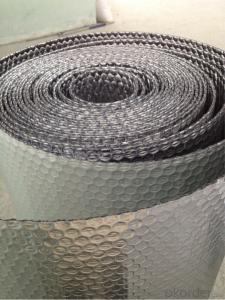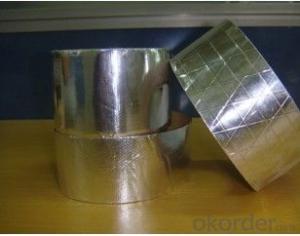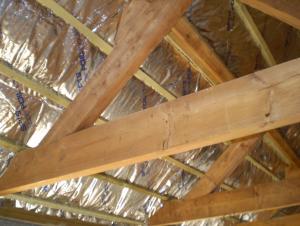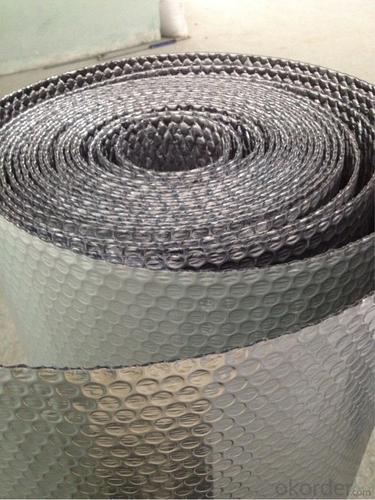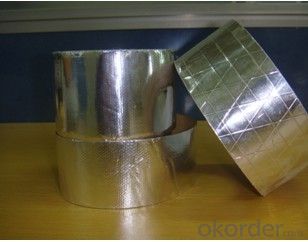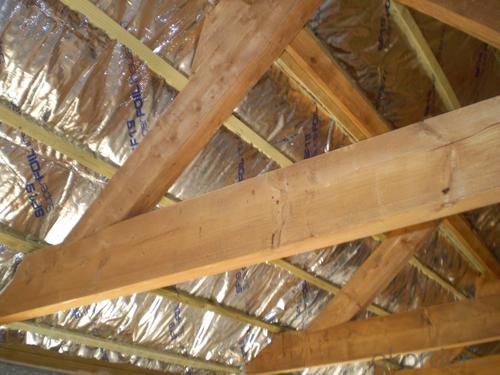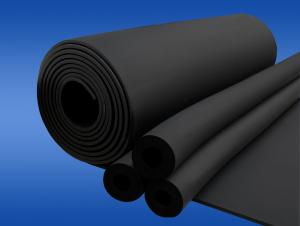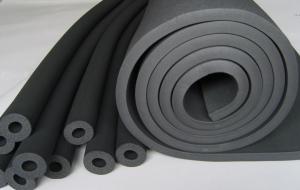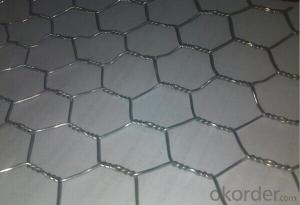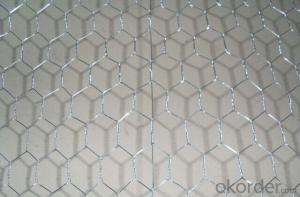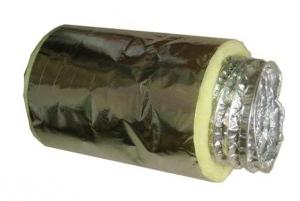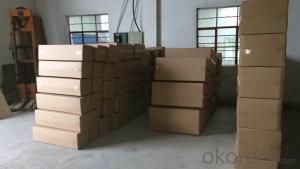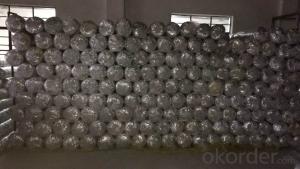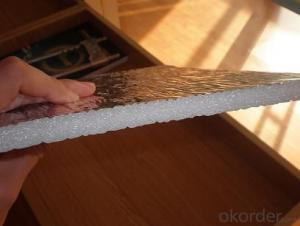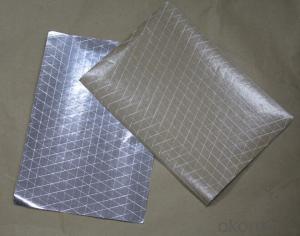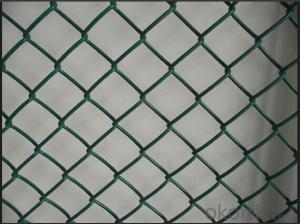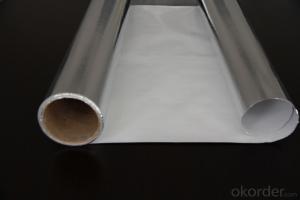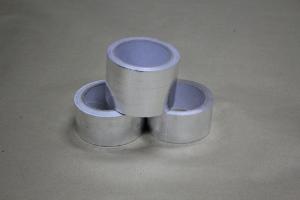Aluminum Foil Facing Insulation Bubble Foil Mylar Film for Heat Seal Al+LDPE
- Loading Port:
- Tianjin
- Payment Terms:
- TT OR LC
- Min Order Qty:
- 3000 m²
- Supply Capability:
- 30000 m²/month
OKorder Service Pledge
OKorder Financial Service
You Might Also Like
Specification
1. Aluminum Foil Mylar Description:
The aluminum foil facing products are mainly used for HVAC system, refrigerators, building thermal aluminum foil facing insulation and laminated with glass wool and rock wool to increase the insulation function.
2.Main Features of the Aluminum foil Mylar:
• High manufacturing accuracy
• Small inertia resistance
• High strength
3.Aluminum Foil Mylar Images
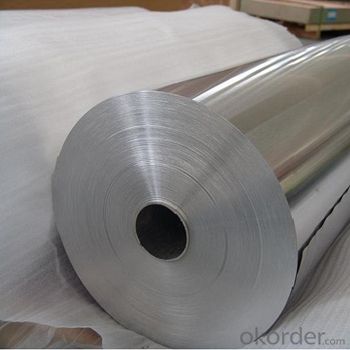
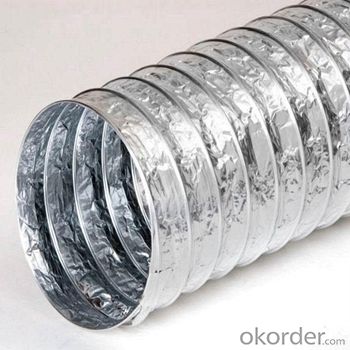
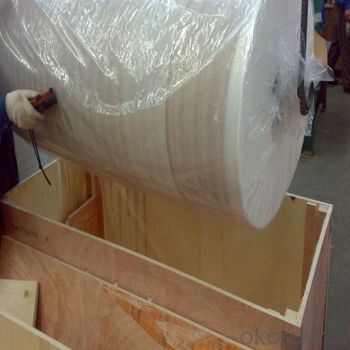
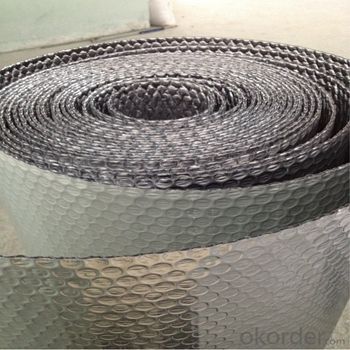
4.Aluminum Foil Mylar Specification
TYPICAL PHYSICAL PROPERTIES:
Name:AL+LDPE | |||
Structure | Thickness(mic) | Weight(g/m2) | Yield(m2/kg) |
AL7+ LDPE12 | 21mic | 36 | |
AL7+ LDPE15 | 24 mic | 39 | |
AL9+ LDPE12 | 23mic | 43 | 23 |
AL9 +LDPE15 | 26mic | 48 | 21 |
AL9 +LDPE19 | 30mic | 54 | 19 |
AL9 +LDPE23 | 34mic | 60 | 17 |
AL12 +LDPE12 | 26mic | 52 | 19 |
AL12 +LDPE15 | 29mic | 56 | 18 |
AL12 +LDPE19 | 33mic | 62 | 16 |
AL12 +LDPE23 | 37mic | 67 | 15 |
AL12 +LDPE36 | 50mic | 87 | 12 |
AL15 +LDPE19 | 36mic | 70 | 14 |
AL25 +LDPE12 | 39mic | 87 | 12 |
AL40 +LDPE36 | 78mic | 161 | 6 |
AL50 +LDPE12 | 64mic | 154 | 6 |
PROPERTIES | UNIT | VALUE | TEST METHOD |
Basic weight | gsm | 80 | ASTM D646 |
Tensile strength: M. D. X. D. | N/25mm | 95 50 | ASTM C1136 |
Burst strength | N | 25 | ASTM D774 |
Reflectivity of foil surface | % | 95 | ---------- |
Temp. Resistance | -29°C +66°C | No change keep soft | ASTM C1263 |
Water vapor permeance | ng/N.s | 1.15 | ASTM E-96 |
Water Soak Test | 24hrs | No delamination | ---------- |
Width: 1.0m, 1.2m, 1.25 m, 1.30, 1.37m
Length: 200m, 500m, 1000m, 2500m, 2750m, 3300m
Core I.D.: 3"(76mm ±1), 72mm ±1
Based on order, special sizes are also available.
5.FAQ
What is the storage condition?
The products should be stored at room temperature and kept from wet and heat source.
It is essential, as with all pressure-sensitive tapes, that the surface to which the tape is applied must be clean, dry, and free of grease and oil.
The user should take test and do trial-application on the above products before coming into application so as to witness and ensure suitability for user’s special purpose and technique.
- Q: Is it possible to utilize a sheet of aluminum foil as a liner for a baking pan?
- <p>Yes, you can use a sheet of aluminum foil as a baking pan liner. It helps prevent food from sticking to the pan and makes cleanup easier. Ensure the foil covers the bottom and sides of the pan, and use enough to fold over the edges for easy removal of baked goods. However, avoid using foil for very high-temperature baking or broiling as it can melt or burn.</p>
- Q: What are the distinctions among various food wraps found in stores?
- <p>Yes, there are differences among food wraps available on the market. They vary in material, such as plastic, aluminum foil, parchment paper, and beeswax wraps. Each type has distinct properties: plastic cling wrap is versatile but not microwave-safe; aluminum foil conducts heat well and is reusable but can tear easily; parchment paper is ideal for baking and can withstand high temperatures; and beeswax wraps are eco-friendly, reusable, and can be used in the fridge or freezer but not for high-heat cooking. Each type also differs in terms of environmental impact, cost, and suitability for different food storage and cooking needs.</p>
- Q: This question is incomplete, but it seems to be asking about special cleaning methods required for a specific situation or item.
- <p>Special cleaning methods can vary greatly depending on the context. For instance, cleaning electronic devices requires anti-static wipes, while cleaning antiques may need gentle, non-abrasive cleaners. In the case of medical equipment, sterilization is crucial. For specific items like carpets, steam cleaning might be necessary. Always refer to manufacturer's instructions or professional guidelines for the best cleaning practices.</p>
- Q: This question asks about potential health or safety risks associated with the use of non-stick coatings on food covers or containers.
- <p>Non-stick coatings on food covers or containers are generally safe when used as directed. However, there are some concerns. High heat can cause these coatings to release potentially harmful fumes or chemicals, such as perfluorooctanoic acid (PFOA), which has been linked to health issues. It's important to avoid overheating non-stick items and to not use them in the oven or broiler. Always follow the manufacturer's guidelines for safe use and cleaning. If the coating is scratched or peeling, it's best to replace the item to prevent ingestion of the coating particles.</p>
- Q: Describe the optimal method for utilizing aluminum foil facing in culinary applications.
- <p>The best way to use aluminum foil facing in cooking is to preheat the oven to the desired temperature, then line the baking sheet or roasting pan with a sheet of aluminum foil, shiny side up. This helps prevent food from sticking and makes cleanup easier. When roasting meats or vegetables, you can also wrap them in foil to retain moisture and speed up cooking. Ensure the foil is not touching the heating elements to avoid fire hazards. For grilling, use foil to wrap foods like corn on the cob or to create a makeshift baking sheet for delicate items. Always be cautious with acidic foods as they can react with the aluminum.</p>
- Q: Is it safe to use aluminum foil facing for storing perishable foods like milk or yogurt?
- <p>Using aluminum foil facing for storing perishable foods like milk or yogurt is generally safe. Aluminum foil doesn't react with these foods and can help maintain freshness by providing a barrier against light and air. However, it's important to ensure that the foil is food-grade and that the container is properly sealed to prevent contamination. Always check the foil for any tears or punctures that could compromise the integrity of the seal. Additionally, avoid using aluminum foil in direct contact with acidic foods as it may cause a reaction over time.</p>
- Q: Can aluminum foil be used as a surface for making pizza crust?
- <p>Yes, you can use aluminum foil facing to make a pizza crust. It's a convenient and non-stick surface that allows the crust to bake evenly and prevents it from sticking. Simply prepare your pizza dough and place it on a piece of aluminum foil sprayed with cooking oil or lined with a silicone mat. Bake according to your pizza recipe, and the aluminum foil will help create a crispy crust.</p>
- Q: This question asks for a method to create a facing made of aluminum foil.
- <p>To make your own aluminum foil facing, you'll need aluminum foil and a suitable adhesive. Start by cutting the aluminum foil to the desired size and shape. Apply a layer of adhesive to the back of the foil, ensuring it's evenly spread. Press the foil onto the surface you want to cover, smoothing out any bubbles or wrinkles. Use a knife or scissors to trim any excess foil. Allow the adhesive to dry completely before handling. This creates a reflective surface that can be used for insulation, decoration, or other purposes.</p>
- Q: What are the most suitable materials for covering food to ensure safety and freshness?
- <p>The best materials for food covers include food-grade silicone, beeswax wraps, and BPA-free plastic. Food-grade silicone is durable, heat-resistant, and can be reused. Beeswax wraps are eco-friendly, reusable, and can be used in the fridge or freezer. BPA-free plastic wraps are commonly used and are good for single use, but ensure they are microwave-safe if you plan to reheat food. Always check for food safety certifications and avoid materials that can leach harmful chemicals into your food.</p>
- Q: Does using aluminum foil facing have any positive effects on health when baking bread?
- <p>Using aluminum foil facing when baking bread does not directly provide health benefits. However, it can help in achieving a more even bake and a better crust, which may enhance the overall quality of the bread. Aluminum foil facing can also prevent bread from burning by reflecting heat away from the bread's surface. While this doesn't impact health, it can improve the bread's taste and texture, which might indirectly contribute to a more enjoyable eating experience and potentially encourage healthier food choices.</p>
Send your message to us
Aluminum Foil Facing Insulation Bubble Foil Mylar Film for Heat Seal Al+LDPE
- Loading Port:
- Tianjin
- Payment Terms:
- TT OR LC
- Min Order Qty:
- 3000 m²
- Supply Capability:
- 30000 m²/month
OKorder Service Pledge
OKorder Financial Service
Similar products
Hot products
Hot Searches
Related keywords
